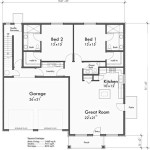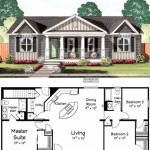Small housing plans are blueprints or designs that outline the construction of compact and space-efficient homes. These plans typically encompass homes with limited square footage, often ranging from 500 to 1,200 square feet. Small housing plans prioritize functionality and livability, maximizing every inch of available space to create comfortable and practical living environments. An example of a small housing plan could be a one-bedroom, one-bathroom home with a combined living and dining area, a compact kitchen, and a small outdoor space.
The adoption of small housing plans has become increasingly prevalent in recent years due to factors such as rising land and construction costs, a growing awareness of environmental sustainability, and a shift towards simpler and more affordable lifestyles. Smaller homes require less land and materials to build, resulting in lower construction costs and a reduced carbon footprint. They are also easier to maintain and often more energy-efficient, contributing to long-term savings on utilities.
In the following sections, we will delve deeper into the advantages and considerations associated with small housing plans, explore different types and designs, and provide practical tips for optimizing space and creating comfortable and stylish small homes.
Small housing plans offer numerous advantages, including:
- Reduced construction costs
- Lower utility bills
- Smaller carbon footprint
- Easier maintenance
- Increased affordability
- Efficient use of space
- Simpler lifestyle
- Greater mobility
These benefits make small housing plans an attractive option for individuals and families seeking affordable, sustainable, and comfortable living environments.
Reduced construction costs
Small housing plans offer significant savings on construction costs compared to larger homes. This cost reduction is primarily attributed to several factors:
- Smaller footprint: Small homes require less land, which can lead to substantial savings on land acquisition costs, especially in expensive urban areas.
- Less material usage: Smaller homes naturally require less building materials, such as lumber, concrete, and roofing, resulting in lower material costs.
- Simplified construction: Small homes often have simpler designs, with fewer complex architectural features, which can reduce labor costs and construction time.
- Fewer permits and inspections: Smaller homes may require fewer permits and inspections, further reducing administrative costs.
Overall, the reduced construction costs associated with small housing plans make them an attractive option for individuals and families seeking affordable homeownership.
Lower utility bills
Small housing plans typically result in lower utility bills, contributing to long-term savings on energy consumption. This cost reduction can be attributed to several factors:
- Smaller space to heat and cool: Smaller homes have less square footage to heat and cool, reducing energy consumption for heating and air conditioning systems.
- Increased energy efficiency: Small homes can be designed with energy-efficient features, such as improved insulation, high-efficiency appliances, and LED lighting, further reducing energy usage.
- Reduced hot water consumption: Smaller homes typically have fewer bathrooms and occupants, leading to reduced hot water consumption and lower water heating costs.
- Lower water and sewage bills: Smaller homes generally consume less water, resulting in lower water and sewage bills.
The combination of these factors contributes to significant savings on utility bills, making small housing plans an attractive option for individuals and families seeking affordable and sustainable living.
Smaller carbon footprint
Small housing plans contribute to a smaller carbon footprint by reducing energy consumption and minimizing resource usage during construction and throughout the home’s lifespan. Smaller homes require less energy to heat and cool, reducing greenhouse gas emissions associated with energy production. Additionally, the use of sustainable building materials and energy-efficient appliances further minimizes the environmental impact.
During construction, smaller homes generate less waste and require fewer resources, such as lumber, concrete, and steel. This reduction in material usage not only lowers construction costs but also reduces the carbon footprint associated with resource extraction, transportation, and manufacturing. Prefabricated homes, which are constructed in a controlled factory setting, can further minimize waste and maximize resource efficiency.
Over the long term, smaller homes continue to have a smaller carbon footprint due to their reduced energy consumption. Smaller homes require less energy for heating, cooling, lighting, and water heating, leading to lower greenhouse gas emissions. Additionally, the use of renewable energy sources, such as solar panels and geothermal systems, can further reduce the carbon footprint of small homes.
Overall, small housing plans promote sustainable living by minimizing resource usage, reducing energy consumption, and lowering greenhouse gas emissions. By choosing a smaller home, individuals and families can contribute to a more sustainable future while enjoying the benefits of affordable and comfortable living.
In summary, the smaller carbon footprint associated with small housing plans stems from reduced energy consumption, efficient resource usage, and the adoption of sustainable building practices. By opting for smaller homes, individuals can make a positive impact on the environment while creating comfortable and affordable living spaces.
Easier maintenance
Small housing plans offer easier maintenance compared to larger homes, requiring less time, effort, and financial resources to keep them in good condition. The reduced square footage means there is less space to clean, repair, and maintain, freeing up time and reducing the burden of homeownership.
Smaller homes often have simpler designs, with fewer rooms and less complex architectural features. This reduces the number of maintenance tasks and the need for specialized skills or equipment. For example, a small home with an open floor plan requires less cleaning and maintenance than a larger home with multiple separate rooms and hallways.
Additionally, smaller homes tend to have more efficient and compact systems, such as heating, cooling, and plumbing. These systems are easier to access and maintain, reducing the likelihood of costly repairs or replacements. Compact kitchens and bathrooms, for example, require less cleaning and maintenance compared to larger, more elaborate spaces.
Furthermore, smaller homes often have lower maintenance costs due to reduced material usage. For instance, a smaller roof requires less frequent repairs and replacements, and smaller windows and doors require less cleaning and maintenance. This can lead to significant savings over the long term.
In summary, small housing plans offer easier maintenance due to their reduced square footage, simpler designs, efficient systems, and lower material usage. This reduced maintenance burden can save time, effort, and money, making small homes an attractive option for individuals and families seeking a low-maintenance lifestyle.
Increased affordability
Small housing plans offer increased affordability, making homeownership more accessible to a wider range of individuals and families. This affordability stems from several key factors:
- Lower construction costs: As discussed earlier, small homes require less land and materials to build, resulting in significant savings on construction costs. This reduced upfront investment makes homeownership more affordable for first-time buyers and those on a budget.
- Reduced property taxes: Property taxes are often based on the size and value of the home. Smaller homes have a lower assessed value, leading to lower property taxes. This ongoing savings can free up more disposable income for homeowners.
- Lower utility bills: As mentioned previously, smaller homes consume less energy and water, resulting in lower utility bills. These monthly savings can add up over time, further increasing affordability.
- Less maintenance costs: Smaller homes have less square footage to maintain, fewer systems to service, and less expensive materials to replace. This reduced maintenance burden can save homeowners money and time, contributing to the overall affordability of small homes.
In summary, small housing plans offer increased affordability due to lower construction costs, reduced property taxes, lower utility bills, and less maintenance costs. These factors make homeownership more accessible and financially feasible for individuals and families seeking affordable and comfortable living spaces.
Efficient use of space
Small housing plans prioritize efficient use of space to create comfortable and functional living environments within a limited footprint. This is achieved through careful planning and design, maximizing every square foot of available space. By incorporating clever storage solutions, multi-purpose furniture, and open floor plans, small homes can provide all the necessary amenities and comforts without feeling cramped or cluttered.
One key aspect of efficient space utilization is vertical storage. Tall bookshelves, wall-mounted cabinets, and loft beds allow for vertical stacking of items, maximizing storage capacity without taking up valuable floor space. Additionally, under-bed storage, pull-out drawers, and built-in organizers help keep belongings tidy and out of sight, creating a more spacious and organized living environment.
Multi-purpose furniture is another effective way to save space in small homes. Ottomans with built-in storage, sofa beds, and dining tables that extend to accommodate more guests are just a few examples of furniture pieces that serve multiple functions. By choosing furniture that can adapt to different needs, homeowners can reduce clutter and make the most of their available space.
Open floor plans are another popular design strategy for small homes. By eliminating unnecessary walls and partitions, open floor plans create a more spacious and airy feel. This allows for better flow of natural light, making the home feel larger and more inviting. Additionally, open floor plans provide more flexibility in furniture placement and allow for multiple activities to occur in the same space.
In summary, small housing plans utilize space efficiently through vertical storage, multi-purpose furniture, and open floor plans. By maximizing every square foot of available space, small homes can provide comfortable and functional living environments without sacrificing style or functionality.
Simpler lifestyle
Small housing plans promote a simpler lifestyle by encouraging individuals to focus on what truly matters and to shed unnecessary possessions and clutter. By living in a smaller space, homeowners can reduce their consumption, simplify their daily routines, and cultivate a more mindful and intentional way of life.
A smaller home requires less time and effort to clean and maintain, freeing up more time for pursuing hobbies, spending time with loved ones, or simply relaxing. Without the burden of excessive possessions, individuals can declutter their lives and focus on experiences and relationships that bring them joy and fulfillment.
Small housing plans often foster a sense of community and shared space. By living in closer proximity to neighbors, homeowners may be more inclined to interact and connect with their surroundings. This can lead to stronger social bonds, a sense of belonging, and reduced feelings of isolation.
Furthermore, smaller homes can promote a more sustainable lifestyle. With less space to fill, individuals are less likely to accumulate excessive belongings and contribute to waste. Additionally, smaller homes typically have a lower environmental impact due to reduced energy consumption and resource usage.
In summary, small housing plans encourage a simpler lifestyle by reducing material possessions, simplifying daily routines, fostering a sense of community, and promoting sustainability. By embracing a smaller living space, individuals can cultivate a more mindful, intentional, and fulfilling way of life.
Greater mobility
Small housing plans offer greater mobility for individuals and families who value flexibility and the ability to move easily.
- Reduced financial burden: Smaller homes are typically more affordable to purchase and maintain, freeing up financial resources that can be used for other expenses, such as travel or relocation costs.
- Fewer belongings: Living in a smaller home encourages a minimalist lifestyle, resulting in fewer belongings to pack and move. This can significantly reduce the time and effort required for relocation.
- Smaller footprint: The compact size of small homes makes them easier to transport and fit into different living situations. Whether moving across town or across the country, a smaller home can be more easily accommodated in various spaces and locations.
- Increased flexibility: Smaller homes provide more flexibility for individuals and families who may need to relocate for work, education, or personal reasons. The reduced financial burden and ease of moving make it easier to adapt to changing circumstances and pursue new opportunities.
In summary, small housing plans promote greater mobility by reducing financial constraints, minimizing belongings, simplifying the moving process, and providing flexibility for individuals and families who value the freedom to move and adapt to changing circumstances.










Related Posts








